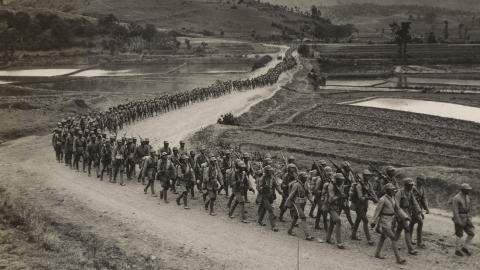Battle of Midway
Perhaps we will be forgiven if we claim we are about midway to our objective!
Admiral Chester Nimitz after the victory at Midway
The Battle of Midway was a decisive episode in the struggle for naval hegemony in the Pacific Ocean, fought in June 1942. As a result of the Battle of the Coral Sea, which had taken place a month earlier, Japanese Pacific expansion had been temporarily halted. Now Japanese admiral Isoruko Yamamoto wanted to force a decisive clash in the Pacific before US industrial power was fully mobilised against Japan. His chosen location was Midway Atholl, a small and solitary archipelago northeast of Hawaii. Yamamoto knew that the US would defend Midway to the bitter end. If the archipelago fell, Hawaii would fall within range of Japanese aircraft, allowing Japan to invade within a matter of weeks.
Yamamoto knew that the US's Pacific aircraft carriers would be despatched to protect the islands; he hoped to lure them into a trap and destroy them. The Japanese occupation of Midway was also part of a plan to push out her defensive perimeter after the Doolittle Raid: a dramatic propaganda air attack on Tokyo launched from the carrier USS Hornet. Furthermore, the Japanese hoped a decisive, humiliating and demoralising defeat in the Pacific would force America to negotiate an end to the war on terms beneficial to Japan.
Yamamoto's plans were scuppered by two principle factors. Firstly, the Japanese underestimated the US's naval strength. They were unaware that the US Yorktown - which had been badly damaged during the Battle of the Coral Sea - had been repaired and was back in action. Secondly, American code breakers were able to determine the exact date and location of the attack. This allowed US Admiral Chester Nimitz to weave an elaborate web of decoy tactics and to plan a deadly pre-emptive ambush. This main US attack, which began at 10:26 on the morning of 4 June, took the Japanese by surprise and succeeded in destroying four aircraft carriers in a matter of hours.
The US Navy inflicted irreversible and debilitating damage upon the Japanese fleet. In contrast, the US lost just one aircraft carrier and a destroyer. Although a number of Japanese pilots did survive, many of the highly trained maintenance teams who ensured the efficiency of ships and aircraft perished in the battle. These heavy losses permanently weakened the Japanese armed forces. While the US continued to construct ships and train new pilots at a huge rate, Midway inflicted losses on the Japanese from which she could not recover. From this point on, the US enjoyed indisputable naval superiority in the Pacific.
Did you know?
The US could read Japanese code; they discovered the attack's location before it began. A fake message was sent outlining water supply problems on Midway. The US then intercepted a Japanese message about water problems on the 'invasion island'
















